Md. Shariful Islam, Fatema Kanak, Md. Asif Iqbal, Kazi Faheema Islam, Abdullah Al Mamun and Md. Sahab Uddin
Department of Pharmacy, Southeast University, Dhaka, Bangladesh.
Corresponding Author E-mail: msu-neuropharma@hotmail.com
DOI : https://dx.doi.org/10.13005/bpj/1422
Abstract
Autism spectrum disorders (ASDs) are a collection of conditions characterized by stereo typed behaviors and narrow interests and pervasive problems with communication and social interactions. Globally, researchers are working on identifying the root cause and management of ASD. Although research on autism is at nascent stage in Bangladesh but in terms of social epidemicity, it is currently an utmost important issue. The aim of the study is to analyze the effect of age, sex, birth weight, mother’s pregnancy duration, pregnancy time complicacy and genetic linkage on autism. The study also related, the socio-economic status of the autistic children and satisfaction of parent on government response in this issue. The study was conducted on 50 patients in 2 Autistic Schools (Bangladesh Protibondhi Foundation and Autistic Children Welfare Foundation, Bangladesh) of the Dhaka City from June 2010 to December 2010. Study related data were collected through a predesigned questionnaire In our study out of 50 children with autism 86% were male and 24% were in the age range between 73to 84 months. About 84% children with autism were lived in urban area and about 52% were belonging at the upper middle class. The main signs and symptoms observed, was prefer to play alone (i.e. 74%). Moreover 60% children with autism talks later than age 2 and 58% had poor eye contact. During our study we have observed that 14% children were linked by heredity and 10% have siblings with same problem. Rett syndrome (i.e. 40%) and autistic disorder (i.e., 32%) were more commonly observed. From the prescription, the study revealed, physicians diagnosed speech delay in 32% patient and 8% were diagnosed with attention deficit hyperactivity disorder. For treatment physicians mainly prescribes vitamins (i.e. 50%), antiepileptic drugs (i.e. 12%), and antipsychotic drugs (i.e. 4%). Besides most of the children were treated with physical and occupational therapy but no objection was found with vaccine. During our study we had observed that, 82% parents were not satisfied by the steps taken by the government yet. This study observed that, apart from alarming increase rate of autism in Dhaka City, modern diagnosis and medication facilities as well as therapies are deficit. Therefore, the new born babies and upcoming parents are at great risk due to insufficiency of awareness. So proper awareness programs and more facilities for autistic children should be introduced by both government and non-government sectors.
Keywords
Autism; Autism Spectrum Disorder; Children; Intellectual Disabilities Neurodevelopment;
Download this article as:| Copy the following to cite this article: Islam M. S, Kanak F, Iqbal M. A, Islam K. F, Al-Mamun A, Uddin M. S. Analyzing the Status of the Autism Spectrum Disorder Amid Children with Intellectual Disabilities in Bangladesh. Biomed Pharmacol J 2018;11(2). |
| Copy the following to cite this URL: Islam M. S, Kanak F, Iqbal M. A, Islam K. F, Al-Mamun A, Uddin M. S. Analyzing the Status of the Autism Spectrum Disorder Amid Children with Intellectual Disabilities in Bangladesh. Biomed Pharmacol J 2018;11(2). Available from: http://biomedpharmajournal.org/?p=20339 |
Introduction
Autism is globally one of the fastest growing neurodevelopment disease with higher impact in social life. The term ASD is currently used to describe autistic disorder, Asperger disorder, Rett disorder, childhood disintegrative disorder and pervasive development disorder- not otherwise specified (PDD-NOS) togather. 1It is characterized by impairments in communication, social skills, speech and nonverbal communication with the presence of repetitive activities. Commonly symptom of autism is expressed before the age of three. 1More accurately, it can be diagnosed at two years of age, with social and communication impairments presenting as primary impairmentsv2,3 A major identifying symptom includes mental retardation, emotional indifference, hyperactivity, aggression, self-injury, and repetitive behaviors (e.g. body rocking, hand flapping etc.).4 Mechanism of autism shows macrocephaly and abnormal neuronal connectivity among autistic individuals and various types of neuronal protein is also observed while using mouse model. Defect in synaptic protein may be another reason of autism development.5 The etiology of autism is a long-debated topic for a last decade but Glasson et al. suggested that autism might be caused due to genetic & environmental factors.6,7 Single gene mutation could be a strong behind reason of genetic syndromes with expressed set of gene with ASD symptoms.8 The drugs approved by the Food and Drug Administration for ASD patients is limited to risperidone (i.e. a dopamine antagonist) and aripiprazole (i.e. a dopamine agonist), which are both aimed at treating irritability and not the core features of ASD8 but research shows promising improvement in early intervention treatment services.9,10 Complementary and alternative treatments such as special diets, chelation, biological, or body-based systems can be a promising alternative approach for pediatricians.11 It is alarming that in every year more children are diagnosed with autism than pediatric acquired immunodeficiency syndrome, cancer and diabetes combined.12
Although Bangladesh has marked a long way progress in reducing mother and child death rate but non-communicable disease like autism is a challenging concern. Globally, the current prevalence of ASD is 1%~2% in the latest large-scale surveys which has increased in past two decades.13,14,15 In USA, the prevalence rate increased shockingly just in 12 years. According to the study of Centers for Disease Control and Prevention, USA; the prevalence was 1 in 150 in the year 2000 which rose into 1 in 68 in 2012.16 Kim et al. guided that, prevalence of Autism disorder in South Korea was 94/10000 in 2011.17 whereas in UK national survey represents prevalence was 98/10000.18 According to the survey conducted by Ministry of Health Family and welfare of Peoples republic of Bangladesh, overall mean prevalence for ASD was 1.55/1000 (n=7280). In Dhaka City the prevalence was 30/1000 and 0.68/1000 in rural populations.12
In personal life autism, not only obstructs performing regular tasks but also hinders taking own decisions. It has substantial effect in retarding normal progress and process of a family. Member of families often struggles with emotional effort which leads them to social exclusion. 19In comparison to parents and siblings, having member with any other physical disabilities feels less stress than parents having children with ASD.20,21 Thus supporting families with ASD member is also a major part of ASD management. Relevant education, anticipatory guidance and even empathetic listening can support the parents and helps to understand patients’ siblings need. Apart from that, public funds, state declared grants, special education, vocational services and other financial subsidies can help to compensate the parents with ASD child.22,23,24,25 Research reports that children with ASD, have difficulties with social relationships at all ages. Their functioning levels in effective communication, sharing enjoyment, interest and emotional reciprocity fails to meet other people.26 The purpose of the study was to undergo root level study on the lifestyle of children with autistic disorder through interviewing the parents, summarizing physicians view by reviewing prescription and observing the child physically. In Bangladesh, lack of research work on Autism tends to scarcity of data. Thus, the study focuses on biophysical parameters, social status, clinical approaches and genetic linkages as well. The study also includes symptomatic identification of autistic children.
Method and Materials
Study Site
The study was conducted on autistics patients selected from two schools (Bangladesh Protibondhi Foundation and Autistic Children Welfare Foundation, Bangladesh) of Dhaka, Bangladesh. Dhaka is a mega city and the capital of Bangladesh with around population of 17 million in 1528Km.2 ,27 School for autistic children is not very popular in Bangladesh but with increasing rate of autistic children a few public and private schools are now operating in this capital. We performed the study in Bangladesh Protibondhi Foundation which is a government owned facility and school for autistic children and Autistic Children Welfare Foundation, Bangladesh which is a private school for autistic children. Our motto is to perform the survey to patient with all economic class, thus these study centers were selected.
Study Design and Data Collection
This was a questionnaire based study conducted among students selected from two schools of Dhaka, Bangladesh. The study was conducted between June 2010 to December 2010 and throughout this period a total of 50 students was selected. Information about sex, age, genetic link with autism, economic status, symptoms and study relevant information were collected and listed.
Ethical Considerations
The study protocol was approved by the Ethics Committee of the Department of Pharmacy, Southeast University, Dhaka, Bangladesh. The study was conducted in accordance with the ethical standards laid down in the 1964 Declaration of Helsinki.
Statistical Analysis
Results were collected, interpreted and presented. For statistical and graphical evaluations Microsoft Excel 2010 (Roselle, IL, USA) was used.
Result
In our study 50 Children with Autism were suffering from Different types of Autistic Spectrum Disorder, were randomly selected from two different study centers during six months study period. We have chosen one Govt. and one non-Govt. schools as study center to study people from all economic study and severity.
Prevalence of Children with Autism by Sex
Amid 50 children with autism, we had observed the probability autism based on sex and observed it is far more common in male which is given in Table 1.
Table 1: Prevalence of children with autism according to sex (n = 50).
| Sex | No. of Patients (n) | % |
| Male | 43 | 86 |
| Female | 7 | 14 |
We can estimate the percentage of male and female children with Autism. We have observed that the percentage of male is higher (86%) than female (14%).
Prevalence of Children with Autism by Current Age
The age of the children was studied to observe the prevalence of autism which is demonstrated in Figure 1. Most of the affected children were in the age range 6 to 7 years.
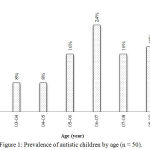 |
Figure 1: Prevalence of autistic children by age (n = 50).
|
Prevalence of Children with Autism by first Noted Age
Parents were questioned about their perception of notifying such problem first time and then the study is observed in Table 2. It was observed that, among the studied children 59.74% were identified at the age range of 2 to 3 years.
Table 2: Prevalence of children with autism by first noted age (n = 50).
| First problem noted at age ( year) | % |
| 2-3 | 59.74 |
| 3-4 | 8.64 |
| 4-5 | 29.31 |
| More than 5 | 2.31 |
Prevalence of Children with Autism by Current Weight
The range of current weight of the children was set according to the lower and upper value. Although different current body weight is also due to their difference in age. Weight of children with autism is given in Table 3. Study shows that, patients with a body weight between 11 to 20 Kg are more frequent to ASD which comprises 68% of the observed data.
Table 3: Prevalence of children with autism by current weight (n = 50).
| Weight(kg) | No. of children with autism (n) | % |
| 0-10 | 2 | 4 |
| 11-20 | 34 | 68 |
| 21-30 | 10 | 20 |
| 31-40 | 4 | 8 |
Prevalence of Children with Autism by Birth Weight
This study included the birth weight variation of the existing children under study. The prevalence of autism in case of children according to birth weight is demographically represented in Figure 2. The outcome reported that the body weight between (2.1 to 3) lb are more affected (38%) by autism
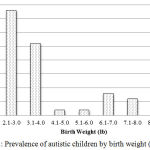 |
Figure 2: Prevalence of autistic children by birth weight (n = 50).
|
Prevalence of Children with Autism by Height
Measuring height may point a way to understand the subtype of autism. As a part of biophysical characteristics, prevalence on children with Autism based on height is also observed and listed on Table 4:
Table 4: Prevalence of children with autism by height (n = 50).
| Height (ft.) | Number of Children with Autism | Prevalence (%) |
| 1.0-3.0 | 31 | 62 |
| 3.1-5.0 | 14 | 28 |
| 5.1-7.0 | 5 | 10 |
It is observed that children with a height between (1.0-3.0) ft are more affected by Autism. Hence it signifies, children with more neonatal age are more vulnerable region to be affected. Around 28% are in between the height range of (3.1-5.0) ft and 10% are in height range of (5.1-7.0) ft.
Socio-Economical Distribution of Autistic Children
The socio-economic status of the population suffering with autism or autism spectrum disorder was studied and demonstrated in Table 5 which shows 84% of the studied children lives in Urban area and 52% of them are from upper middle class.
Table 5: Socio-economical distribution of autistic children (n = 50).
| Place of living | Number of children | Prevalence (%) | Social status | Number of children | Prevalence (%) |
| Rural | 1 | 2 | Rich | 6 | 12 |
| Urban | 42 | 84 | Upper Middle | 26 | 52 |
| S-Urban | 4 | 8 | Lower Middle | 9 | 18 |
| Other | 3 | 6 | Poor | 9 | 18 |
The socio-economic status observed in Table 3.5 shows, around 52% parents of autistic children belong to upper middle class and 18%are from poor class. The result of our study might reflect the effect of working parents and their tendency to give less time to their children. It may be also a reason of one of occupational hazard that mothers suffer during pregnancy.
Signs and Symptoms of Autism
There are several signs and symptoms were observed in children with Autism. Most of the autistic children have multiple signs and symptoms mentioned in the data collection form. Hence, all the data presented here is based on the data provided by the parents. The prevalence of the sign and symptoms on studied population is presented Figure 3.
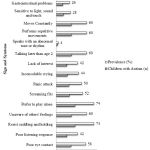 |
Figure 3: Parents review about the signs and symptoms of autistic children |
Along with 60% prevalence, important symptoms were signified as unaware of others’ feelings, talking later than age 2 performs repetitive movements’ moves constantly etc. Besides, from prescription indication a brief review on physician’s view was observed in Table 6.
Table 6: Prescription review about signs and symptoms of autistic children and their prevalence (n = 50).
| Prescription reviewed Indication | No. of observation (n) | % |
| Speech Delay | 16 | 32 |
| Behavioral Problem | 12 | 24 |
| Psychomotor Delay | 8 | 16 |
| Hyper ammonemia | 4 | 8 |
| Lack of interest | 4 | 8 |
| Non- Convulsive Seizure | 4 | 8 |
| Frequently poor attention | 2 | 4 |
Types of Autistic Disorder According to Physician’s Diagnosis
According to physician’s prescription we represented the classification of disorders observed in Figure 4. Autistic disorder (40%) was dominating in observed children suffered by 20 out of 50 children.
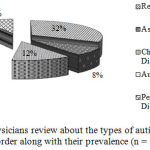 |
Figure 4: Physicians review about the types of autism spectrum disorder along with their prevalence (n = 50).
|
Types of Drugs Prescribed in Autism Spectrum Disorder
Physician’s opinion is, in case of autism most of the physicians do not encourage prescribing drugs. However antipsychotic drugs were more popular based on hyper or hypo attitudes shown by the children. After analyzing the prescription of the patient we found a number of drugs were used in different condition given in Figure 5.
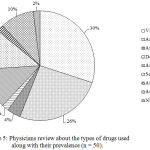 |
Figure 5: Physicians review about the types of drugs used along with their prevalence (n = 50).
|
Pregnancy History and Mother’s Health Condition Analysis
Several possible conditions during pregnancy were taken into consideration during study. Like other developing countries of the world, in some cases Bangladeshi mothers take child at early age. Thus, we had considered it as a factor of premature baby delivery which may finally tend to autism. The data is consolidated and represented in Table 7.
Table 7: Pregnancy history and health status of the mother of autistic children (n = 50).
| Pregnancy History | Parents review | Prevalence (%) | ||||
| Mother’s age at birth | A)19-24
N = 22 |
B)25-30
N = 15 |
C) 31-35
N = 13 |
A) 44 | B) 30 | C) 26 |
| Mother’s education level | A) Graduate
N = 27 |
B) Undergraduate
N = 23 |
A) 54 | B) 46 | ||
| Duration of pregnancy | A) 7-8month
N = 16 |
B) 8-9month
N = 30 |
C) 9-up month
N = 4 |
A) 32 | B) 60 | C) 8 |
| Mother’s overall health | A) Good
N = 38 |
B) Poor
N = 10 |
C) Very poor
N = 2 |
A) 76 | B) 20 | C) 4 |
| The birth take place in | A) Home
N = 9 |
B) Hospital
N = 41 |
A) 18 | B) 82 | ||
| Way of delivery | A) Natural
N = 33 |
B) Cesarean
N = 17 |
A) 66 | B) 34 | ||
| Was labor induced with | A) Pitocin\Oxytocin
N = 27 |
B) Does not
N = 23 |
A) 54 | B) 46 | ||
| Complication during delivery | A) Yes
N = 18 |
B) No
N = 32 |
A) 36 | B) 64 | ||
Besides pregnancy condition, mother’s disease profile was also taken into account. Immunological disorder might have an impact on autism and intake of antibiotic may show a direct or indirect effect. The associated data are tabulated in Table 8.
Table 8: Mothers disease profile of autistic children (n = 50).
| Mothers disease profile | Yes | Prevalence (%) | No | Prevalence (%) |
| Mother suffered with immune system disorder | 12 | 24 | 38 | 76 |
| Allergies during pregnancy | 15 | 30 | 35 | 70 |
| Antibiotics taken during the pregnancy | 9 | 18 | 41 | 82 |
| Pain killers taken during pregnancy | 14 | 28 | 36 | 72 |
| Zinc, Iron & folic Acid taken during pregnancy | 34 | 68 | 16 | 32 |
| The child takes breast milk | 37 | 74 | 13 | 26 |
Familial and heritable recurrence is one of the major genetic linkage identification efforts. Percentage of siblings having ASD was found. By heritability, ASD was identified in a few families although there is possibility of having unidentified family members among predecessor. The results are tabulated in Table 9.
Table 9: Mothers disease profile of autistic children (n = 50).
| Familial & Heritable recurrence | Yes | Prevalence (%) | No | Prevalence (%) | N/A | Prevalence (%) |
| Does anyone in the family or genetically linked relative have autism too? | 7 | 14 | 43 | 86 | – | – |
| Does any sibling diagnose with same or similar disorder? | 5 | 10 | 25 | 50 | 20 (No Sibling) | 40 |
Around 86% of the patient have no known genetically linked relative who had similar type disorder. Patient have siblings with similar type of disorder are almost 10%.
Frequency of Hospital Supervision
Frequency of hospital supervision indicates patient’s physiological status and frequency to undergo sickness. In this study, the hospital supervision frequency was listed in Table 10. The study reveals that around 56% of the studied children undergo hospital supervision or private clinic for physician advice or disease related treatment whereas 14% visits physician weekly or more.
Table 10: Frequency of hospital supervision of autistic children (n = 50).
| Times/month | Number of children (n=50) | Prevalence (%) |
| (0-1) | 6 | 12 |
| (1-2) | 28 | 56 |
| (2-3) | 9 | 18 |
| (4-Above) | 7 | 14 |
Hence, our study also included types of hospital used by the patients. It interprets parents financial condition and types of treatment availed by the children. The data is tabulated and graphically shown in Figure 6. The study shows that around 56% parents chooses government hospital for treatment, an important reason may be affordable treatment cost and availability of selected medicine at free of cost. However, comparatively solvent parents move towards private hospital (32%).
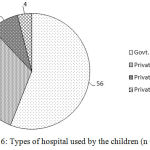 |
Figure 6: Types of hospital used by the children (n = 50).
|
Satisfaction Upon Government Response Towards the Crisis
Government is taking different types of steps to help parents and children as well in perspective of treatment and social status. Current study includes parent’s satisfaction on nationwide taken steps. The data is graphically shown in Figure 7 explains that, around 82% parents are not satisfied with the steps taken by government
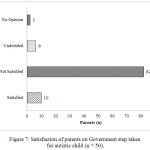 |
Figure 7: Satisfaction of parents on Government step taken for autistic child (n = 50).
|
Discussion
ASD is now one of the most progressive threatening diseases that should be studied from different point of views. In this study we studied the profile of ASD in Bangladesh and reviewed studied data from biophysical angle to impact of social class view.
In our study, we have observed that the prevalence percentage of male is higher (86%) than female (14%). Paul et al. also reported 80.9% screening of male candidate whereas female percentage is only 19.1%28. According to Mattila et al. ASD appears 2-3 times in males rather than females. 13,14,15Lazoff et al. reported the age range to be (5-17),29 are more affected by autism. In our study we had found similar results where the children of the age range of (06-07) years were significantly affected. Vijay Sagar reported that, mean age at referral was 42.8 months (3.5 Year) and it ranged from 34 to 56 months which is ultimately in between 2.8 year to 4.6 Year.30We had observed that, 59.74% of the studied children were between the age range of 02 to 03 years and around 29.31% were detected lately in between the age of 4 to 5 years. May be a reason would be that expert physicians can identify autistic disorder around at the age of 02 years whereas Asperger syndrome and pervasive developmental disorder not otherwise specified are much difficult to identify before the age (4-5).31
In the study Paul et al. demonstrated that around 80.9% of the studied male children were identified at the age of 5.6 years whereas female children were identified at the median age of 6.1 year.28 As low birth weight contributes to ASD,32 our study revealed that, the body weight between 2.1 to 3.0) kg children (i.e. 38%) are more affected by autism. In multivariate analyses it is observed that, birth weight of less than 2500 g increases almost two-fold risk of autism.33 We had observed that, majority (52%) of our patients are from upper middle class. This study was supported by Bernard et al. who observed 51.1% of the candidates were from upper middle class.34The result of our study, might reflect the effect of working parents and their tendency to give less time to their children. It may be also a reason of one of occupational hazard that mothers suffer during pregnancy. In Singapore, odd play was reported 36% 34. We had observed 74% children plays alone which really odd. Along with 60% prevalence, important symptoms were unaware of others’ feelings, talking later than age 2, performs repetitive movements, moves constantly. We have found 24% of our patient had behavioral problem. Behavioral problem was also reported in 25% patient in Sinagpore. 34Paul et al. reported 37.7% patient suffering with autistic disorder28. We had observed it in almost similar value (i.e. 40%). In Bangladesh, we found physicians are more likely to prescribe vitamins (i.e. 30%) with a probable intention of accelerating development and refilling malnutrition-based deficiencies. According to general and more predictive trend antipsychotics (i.e. 26%) were also prescribed in remarkable number. In spite of having alternative treatment process, parents who believe that, autism of child is due to mother’s disease during pregnancy are more like to take medication.35Study shows antipsychotics like risperidone and fluoxetine shows promising results in irritability, hyperactivity and speech deviance, social withdrawal, stereotypy actions subsequently30.
Around 44% of mothers were within the range of (19-24) years which also considered as traditional age of marriage for people with low educational and economic status in Bangladesh. Almost the same age range (20-29) was reported by Paul et al. with highest prevalence 34.9%28. However, in Bangladesh the education level of women in Bangladesh is raised, the present study reflects 54% of the studied mothers were graduated which Paul et al. reported as 13.1%28 in their study. Only 8% of mother reported they had full term of pregnancy which is considered here ≥ 9 month and 60% reported their pregnancy duration was within 8 to 9 months, however 76% claimed to be in good health during pregnancy. It is also reported that, preterm birth at prior 33 weeks increasers risk of autism in two fold33. 68% parents in USA and Canada believe, premature birth is a prime reason of ASD.36 Around 36% reported that had complication during delivery and perinatal period while in India it is reported to be 25%30. Mercer et al. reported around 43% parents believe complication during pregnancy is the reason behind ASD.36
Another remarkable data revealed here as 82% of affected child were born in hospital and 18% of the total studied population were delivered by natural method. A study in India reported similar results where 75% mother of the affected children were delivered in natural process and 18.8% were in cesarean process30 whereas, in Singapore, 95% of the cases pregnancy was normal with 88% of the parents reporting normal birth34. 54% of the studied mothers were treated with pitocin or oxytocin to induce labor pain. Besides pregnancy condition, mother’s disease profile was also taken into account. Immunological disorder might have an impact on autism and intake of antibiotic may show a direct or indirect effect. We had found 76% of studied mother were suffered immunological disorder prior or during their pregnancy and 70% suffered with allergy during pregnancy. Meadan et al. reported, parents of the children had more stress during taking child in comparison to parents of the normal children.37Among the mothers of autistic children 82% were in emergency condition to take antibiotics during pregnancy. However, most of them (68%) taken common supplementary zinc, iron and folic acid during pregnancy. It is also a matter of fact that, such behavioral disorder did not deviated child from intrinsic behavior like taking breast milk (74%). Around 86% of the patient had no known genetically linked relative who had similar type disorder. We have observed, around 10% patient have siblings with similar type of disorder which is quite similar to the results obtained by Chakrabarti et al.38 and Muhle et al.39 where 2% to 8% had found with similar disorders. 5-8% recurrence rate was also described in the study of Szatmari et al. It also describes siblings have 50% greater risk in recurrence.40 Gene defects including single-gene disorders are also reported in 5% individuals with ASD.41
In USA and Canada more than 90% believe ASD diagnosis could be related to genetics36. Our study showed that around 56% parents chooses government hospital for treatment, an important reason may be affordable treatment cost and availability of selected medicine at free of cost. Also, as autistic children need emergency room almost more than nine times than a normal child, it can also be a prime reason to visit government hospital.42We had observed that, majority (52%) of our patients are from upper middle class. This study was supported by Bernard et al. who observed 51.1% of the candidates were from upper middle class34.The result of our study, might reflect the effect of working parents and their tendency to give less time to their children. It may be also a reason of one of occupational hazard that mothers suffer during pregnancy. We had observed that, around 82% parents were not satisfied with the steps taken by government. Although as per the recent government policy, a number of projects are under construction to serve existing and future autistic children.
Conclusion
The finding of the study revealed that the biophysical parameters (such as sex, birth weight etc.) and correspondent results, that should be considered for fathoming the future prevalence of autism in Bangladesh. Moreover, the study signifies the identification age of autism and other family perspective that should be considered by parents such as heredity and affected siblings. Mother with full term pregnancy level and healthy weight baby reduces chances of autism which is a remarkable sign for studying autism globally. Apart from a few remarkable developments in child survival rate, Bangladesh is heading towards the threat of non-communicable disease along with the whole world. Although in shortest period of time, Bangladesh has identified this problem but it is high time to establish social setup for resolving such problems. As there is still no large survey-based program to identify actual prevalence; it will be very difficult to plan resources. Further details study is needed on life style of children and parents. According to our opinion, biochemical linkage of genetic responses should be in prime concern of study throughout different generations to have a clear prediction on future threats of autism.
Limitation
The present study was conducted in two school of Bangladesh with only 50 volunteers. It would be best if we could accomplish this study in numerous schools all over the country.
Acknowledgement
We would like to thank Department of Pharmacy, Southeast University for logistic support. Our cordial thanks to Bangladesh Protibondhi Foundation and Autistic Children Welfare Foundation, Bangladesh for their permission and cooperation to conduct this survey.
Funding
The author(s) received no financial support for the research, authorship, and publication of this manuscript. The author(s) funded the research on their own.
Conflict of Interests
The authors proclaim that they have no conflict of interests.
Reference
- Faras H, Al Ateeqi N. and Tidmarsh L. Autism spectrum disorders. Annals of Saudi Medicine. 2010;
CrossRef - Lord C. Follow-up of two-year-olds referred for possible autism. J. Child Psychol Psychiatry. 1995; 36(8):1365-1382.
CrossRef - Stone W.L, Lee E.B, Ashford L, Brissie J and Hepburn S.L et al. Can autism be diagnosed accurately in children under 3 years? .J. Child Psychol Psychiatry. 1999;40(2):219-226.
CrossRef - Park H. R, Lee J. M, Moon H. E, Lee D. S.and Kim B.-N. et al. A Short Review on the Current Understanding of Autism Spectrum Disorders. Exp Neurobiol, 2016.25.1.1 http://doi.org/10.5607/. 2016;25(1):1–13.
- Won H, Mah W. and Kim E. Autism spectrum disorder causes, mechanisms, and treatments: focus on neuronal synapses. Front Mol Neurosci. 2013;6:19. http://doi.org/10.3389/fnmol.2013.00019.
CrossRef - Glasson E .J, Bower C, Petterson B, de Klerk N and Chaney G et al. Perinatal Factors and the Development of Autism A Population Study. Arch Gen Psychiatry. 2004;61(6):618–627.
doi:10.1001/archpsyc.61.6.618
CrossRef - Newschaffer C.J, Croen L.A, Daniels J, Giarelli E. and Grether J.K. The epidemiology of autism spectrum disorders. Annu Rev Public Health. 2007;28:235-258.
CrossRef - Rotheram-Fuller, E, Kasari C, Chamberlain B. and Locke J. Social Involvement of Children with Autism Spectrum Disorders in Elementary School Classrooms. J. Child Psychol Psychiatry. 2010;51(11):1227–1234. http://doi.org/10.1111/j.1469-7610.2010.02289.x
CrossRef - Handleman J.S. and Harris S. Preschool Education Programs for Children with Autism. 2nd Edn., Austin, TX: Pro-Ed. 2000.
- National Research Council. Educating Children with Autism. Washington D.C. National Academy Press. 2001.
- Gupta and Bhushan, V. Complementary and Alternative Medicine. New York Medical College and Columbia University. 2004.
- LeeY.J, Oh S.H, Park C, Hong M, Lee A. R. and Yoo. H. J. et al. Advanced pharmacotherapy evidenced by pathogenesis of autism spectrum disorder. Clin Psychopharmacol Neurosci. 2014;12(1):19.
CrossRef - Mattila M.L, Kielinen M, Linna S.L, Jussila K and Ebeling H et al. Autism spectrum disorders according to DSM-IV-TR and comparison with DSM-5 draft criteria: an epidemiological study. J. Am Acad 14. Child Adolesc Psychiatry. 2011;50(11):583–592.
CrossRef - Kim Y.S, Leventhal B.L, Koh Y.J, Fombonne E and Laska E et al. Prevalence of autism spectrum disorders in a total population sample. Am. J .Psychiatry. 2011;168:904–912.
CrossRef - Fisch G.S. Nosology and epidemiology in autism: classification counts. Am .J. Med Genet C Semin Med Genet. 2012;160C:91–103. doi:10.1002/ajmg.c.31325.
CrossRef - Christensen D.L, Baio J and Braun K.V et al. Prevalence and Characteristics of Autism Spectrum Disorder Among Children Aged 8 Years-Autism and Developmental Disabilities Monitoring Network, 11 Sites, United States, 2012. MMWR Surveill Summ. 2016;65(33):1–23.
CrossRef - Elsabbagh M, Divan G, Koh Y.-J, Kim Y. S. and Kauchali S. Global Prevalence of Autism and Other Pervasive Developmental Disorders. Autism Res. 2012;5:160–179. doi:10.1002/aur.239
CrossRef - Meltzer H, Bebbington P, Brugha T, Jenkins R, McManus S, and Dennis M. Personal debt and suicidal ideation. Psychol. Med. 2011;41(4):771-778. doi: 10.1017/S0033291710001261
CrossRef - Nealy C.E, O’Hare L, Powers J.D. and Swick D.C. The impact of autism spectrum disorders on the family: A qualitative study of mothers perspectives. J. Fam Soc Work. 2012;15(3):187-201.
CrossRef - Bågenholm, A and Gillberg C. Psychosocial effects on siblings of children with autism and mental retardation: a population-based study. J. Ment Defic Res. 1991;35:291–307
- Bouma, R and Schweitzer R. The impact of chronic childhood illness on family stress: a comparison between autism and cystic fibrosis. J. Clin Psychol. 1990;46:722–730
CrossRef - Myers S.M, and Johnson C. P. Management of children with Autism spectrum disorders pediatrics. 2007; 120(5):1162-1182.
- Dumas J.E, Wolf L.C, Fisman S.N. and Culligan A. Parenting stress, child behavior problems, and dysphoria in parents of children with autism, Down syndrome, behavior disorders, and normal development Exceptionality. 1991;2:97-110.
CrossRef - Gold N. Depression and social adjustment in siblings of boys with autism. J. Autism Dev Disord. 1993;23:147–163.
CrossRef - Gray D.E. Ten years on: a longitudinal study of families of children with autism. J. Intellect Dev Disabil. 2002;27:215–222
CrossRef - AP.A. American Psychological Association. Diagnostic and statistical manual of mental disorders. Washington, D.C.2000.
- Uddin M.S, Mamun A. Al, Asaduzzaman M, Hosn F and Sufian M.A et al. Spectrum of Disease and Prescription Pattern for Outpatients with Neurological Disorders: An Empirical Pilot Study in Bangladesh. Ann Neurosci. 2018;25(1):25-37.
CrossRef - Shattuck P.T, Durkin M, Maenner M, Newschaffer C, and Mandell D.S. et al. Timing of identification among children with an autism spectrum disorder: findings from a population-based surveillance study. J. Am Acad Child Adolesc Psychiatry. 2009;48(5):474-83.
CrossRef - Lazoff T, Zhong L, Piperni. T, Med and Fombonne. E. Prevalence of pervasive developmental disorders among children at the English montreal school board. Can .J. Psychiatry. 2010;55(11):715 -720.
CrossRef - Vijay Sagar K.J. Research on autism spectrum disorders in India. AP.J. Psychol Med. 2011;12(1):69-72.
- Lord C and Spence S. Autism spectrum disorders: phenotype and diagnosis. In: Understanding Autism, Moldin SO, Rubenstein JLR, (Eds.): From Basic Neuroscience to Treatment: New York: CRC Taylor and Francis;1Y23. 2016
- Kolevzon A, Gross R and Reichenberg A. Prenatal and perinatal risk factors for autism: a review and integration of findings. Arch Pediatr Adolesc Med. 2007;161:326-333.
CrossRef - Tanya Karapurkar Bhasin. Birth Weight and Gestational Age Characteristics of Children with Autism, Including a Comparison with Other Developmental Disabilities Diana Schendel. Pediatrics. 2008;121(6) 1155-1164. 34. Bernard-OpitzV, Kwook K. W, and Sapuan S. Epidemiology of autism in Singapore: findings of the first autism survey. Int .J. Rehabil Res. 2001;24(1):1-6.
- Dardennes R. M, Al Anbar N. N, Prado-Netto A, Kaye K, Contejean Y. and Al Anbar N.N. Treating the cause of illness rather than the symptoms: parental causal beliefs and treatment choices of autism spectrum disorder. Res Dev Disabil. 2011;32(3):1137-1146. doi: 10.1016/j.ridd.2011.01.010
CrossRef - Mercer L, Creighton S, Holden J.J.A. and Lewis M. E. S. Parental perspectives on the causes of an autism spectrum disorder in their children. J. Genet Couns. 2006;15(1):41-50. doi:10.1007/s10897-005-9002-7.
CrossRef - Meadan H, Halle J. W. and Ebata A. T. Families with children who have autism spectrum disorders: Stress and support. Exceptional Children. 2010;77(1):7-36.
CrossRef - Chakrabarti S and Fombonne E. Pervasive developmental disorders in preschool children. JAMA. 2001;285: 3093–9.
CrossRef - Muhle R, Trentacoste S.V and Rapin I. The genetics of autism. Pediatrics. 2004;113(4):72–86. Available from: http://www.pediatrics.aappublications.org/cgi/reprint/113/5/e472. Accessed March 08, 2018
- Szatmari P, Jones M.B, Zwaigenbaum L and MacLean J.E. Genetics of autism: overview and new directions. J. Autism Dev Disord. 1998;28:351–368.
CrossRef - Miles J.H. Autism spectrum disorders–a genetics review. Genet Med. 2011;13:278–294.
CrossRef - Kennedy Krieger Institute. Children with autism arrive at emergency room in times of psychiatric crisis nine times more than peers. Available from: https://www.kennedykrieger.org/overview/news/children-autism-arrive-emergency-room-psychiatric-crisis-nine-times-more-than-peers Accessed March 08,2018







